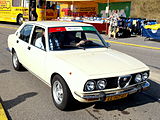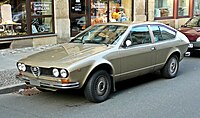Alfa Romeo Alfetta
| Alfa Romeo | |
|---|---|
|
Alfa Romeo Alfetta (1972-1975)
|
|
| Alfetta | |
| Production period: | 1972-1984 |
| Class : | upper middle class |
| Body versions : | Limousine , station wagon coupé |
| Engines: |
Otto engines : 1.6–2.5 liters (80–116 kW) Diesel engines : 2.0–2.4 liters (60–70 kW) |
| Length: | 4280-4380 mm |
| Width: | 1613-1630 mm |
| Height: | 1430-1435 mm |
| Wheelbase : | 2510 mm |
| Empty weight : | 1070-1250 kg |
| Previous model | Alfa Romeo Berlina 1750/2000 |
| successor | Alfa Romeo 90 |
The Alfetta is a four-door upper middle class sedan from Alfa Romeo , which was built from spring 1972 to autumn 1984.
The vehicle was located above the Alfa Romeo Giulia and competed with the Berlina 1750/2000, which had been manufactured in-house since the beginning of 1968 . When the Alfetta was launched, it was received positively in the specialist press and among international customers.
history
Surname
The name comes from the Alfa Formula 1 racing car Alfetta type 159 , with which Giuseppe Farina in 1950 and Juan Manuel Fangio in 1951 took first places. The name "Alfetta" means "little Alfa". The reason for the same name was the drive train . In both types of vehicle, the engine was installed at the front and that - together with the differential - was installed at the rear. This construction, also known as the transaxle , was rare in series vehicles after the First World War (examples: Csonka , Škoda Popular , Lancia Aurelia ).
Market success
The Alfetta was initially a great market success. In the magazine auto, motor und sport , the car won a comparison test with the BMW 520 , which was newly published in September 1972, because of its lower price. Problems with the Alfetta, however, were a lack of technical reliability and the high susceptibility to rust. Other Alfa Romeo models also had these problems in the 1970s, which permanently damaged the brand's reputation. The successor model Alfa 90 was presented in autumn 1984.
technology
Powertrain
The Alfetta's gearbox was in front of the rear axle. The clutch housing was flanged in front of the gearbox. The drive shaft contained three Giubo clutches for vibration decoupling , rotated at engine speed and connected the engine in the front with the rear unit consisting of clutch, gearbox and differential. The masses are evenly distributed on both axles (weight distribution of 50:50) and thus put more weight on the drive wheels than conventional rear-wheel drive, which improves traction .
In addition, this enables neutral behavior when cornering, regardless of the load condition. While this design relieved the load on the front axle and thus made the rack and pinion steering easier, on the other hand the additional load on the rear axle of the Alfetta helped to improve road holding, even under poor conditions such as rain and snow.
landing gear
The Alfetta had a De Dion axle with coil springs and telescopic shock absorbers. This construction combines the advantages of the rigid axle (track and camber constancy) and those of the independent wheel suspension (low unsprung mass, comfort) due to the differential located on the body. The axle beam was roughly in the shape of a trapezoid, the narrow side of which pointed forward. There the axle was mounted in rubber in front of the gearbox (drawbar axle). A watt rod behind the axle was used for lateral guidance at the rear . The rear brake discs were on the inside, i.e. flanged directly onto the differential output shafts. The unsprung masses on the wheels were further reduced.
On the front axle there were double wishbones and longitudinal torsion bar springs (torsion bar springs) to create space in the engine compartment. The development took place before the oil crisis of 1973 and it should be possible to install larger engines, such as the V8 from Montreal .
The Alfetta had four servo-assisted disc brakes.
engine
The car was offered with the 1750 engine with 1779 cc and 122 hp (90 kW), which Alfa-Romeo also used in other vehicles. The 2000 engine with 121 hp (89 kW) followed in 1977, later also 130 hp (96 kW), and in early 1975 the 1600 engine from the Alfa Romeo Giulia was the entry-level model. The 1600 engine in the Alfetta was slightly more powerful than the one in the Giulia Nuova Super, which was still being built, due to various fine-tuning and an electric fan. In 1979 the Alfetta was also offered for the first time with a turbodiesel engine that produced 82 hp (60 kW) and, by increasing the displacement to 2.4 liters, from 1983 95 hp (70 kW). In the USA, the two-liter engine from the previous models with mechanical Spica intake manifold injection and 82 kW (112 hp) was used from 1975 , later the 2.5-liter V6 in the GTV . In the last version from 1983 a motor with Bosch Motronic and an adjustable intake camshaft was installed.
Equipment and design
The equipment of the vehicle corresponded to the requirements of an upper middle class limousine. The design comes from Bertone . However, since Alfa President Giuseppe Luraghi was in trouble with Bertone, this was never made public, on the contrary: The first version of the Alfetta had a “Centro Stile Alfa Romeo” emblem. This "original" Alfetta was built from March 1972 to July 1974.
From mid-1974 there was also the Alfetta with a 1600 engine (sales name: Alfetta 1.6), a kind of economy version (this can be recognized from the outside by the single headlights and hornless bumpers).
From the beginning of 1975, the previous Alfetta was called Alfetta 1.8 and underwent a few small external revisions in the form of a wider Alfa heart ("Scudetto"), different headlight rings and a modified front grille.
In the autumn of 1977, the Alfetta 2000 finally appeared with a heavily modified and new design , including rectangular headlights, wider bumpers, a hood that opened to the rear and screwed instead of welded front fenders. From autumn 1979 the Alfetta Turbo Diesel (2 liter displacement) was available with the same shape and at the beginning of 1983 the Alfetta with 2.4 l turbo diesel was added.
In the spring of 1982 further modifications were made. In addition to wide plastic panels on the sides, double headlights were partially installed again. In contrast to the first version, the bumpers with side plastic corners, introduced in autumn 1977, continued to sit underneath.
Alfetta GTV
As is usual with Alfa Romeo, other variants were also offered on the basis of a successful model. The three-door sports coupe Alfetta GT or GTV appeared in spring 1974 as a supplement . This model was later also available with a V6 engine.
In the fall of 1980, the coupé, now known as the GTV, received a fundamental facelift. The models received bumpers, spoilers and side panels made of plastic. Furthermore, the dashboard and taillights have been redesigned.
By the beginning of 1986, 478,812 copies had been produced.
literature
- Alfa Romeo Alfetta Coupé GT / GTV / GTV6 by Umberto Di Paolo / ISBN 978-3-95843-695-4 Heel Verlag 2018
Web links
Individual evidence
- ↑ Comparative test BMW 520 and Alfa Romeo Alfetta in auto motor und sport , issue 8/1973, page 45
- ↑ Photo of the removed axle
- ^ Automobil Revue , catalog numbers 1977 and 1979, p. 163 and 178
| Timeline of Alfa Romeo models from 1945 to today | ||||||||||||||||||||||||||||||||||||||||||||||||||||||||||||||||||||||||||||
|---|---|---|---|---|---|---|---|---|---|---|---|---|---|---|---|---|---|---|---|---|---|---|---|---|---|---|---|---|---|---|---|---|---|---|---|---|---|---|---|---|---|---|---|---|---|---|---|---|---|---|---|---|---|---|---|---|---|---|---|---|---|---|---|---|---|---|---|---|---|---|---|---|---|---|---|---|
| Type | Independent until 1933, then state-owned | from 1986 part of Fiat | ||||||||||||||||||||||||||||||||||||||||||||||||||||||||||||||||||||||||||
| 1940s | 1950s | 1960s | 1970s | 1980s | 1990s | 2000s | 2010s | 2020s | ||||||||||||||||||||||||||||||||||||||||||||||||||||||||||||||||||||
| 5 | 6th | 7th | 8th | 9 | 0 | 1 | 2 | 3 | 4th | 5 | 6th | 7th | 8th | 9 | 0 | 1 | 2 | 3 | 4th | 5 | 6th | 7th | 8th | 9 | 0 | 1 | 2 | 3 | 4th | 5 | 6th | 7th | 8th | 9 | 0 | 1 | 2 | 3 | 4th | 5 | 6th | 7th | 8th | 9 | 0 | 1 | 2 | 3 | 4th | 5 | 6th | 7th | 8th | 9 | 0 | 1 | 2 | 3 | 4th | 5 | 6th | 7th | 8th | 9 | 0 | 1 | 2 | 3 | 4th | 5 | 6th | 7th | 8th | 9 | 0 | |
| Small car | MiTo (955) | |||||||||||||||||||||||||||||||||||||||||||||||||||||||||||||||||||||||||||
| Compact class | Arna | |||||||||||||||||||||||||||||||||||||||||||||||||||||||||||||||||||||||||||
| Alfasud | 33 | 145 , 146 (930) | 147 (937) | Giulietta (940) | ||||||||||||||||||||||||||||||||||||||||||||||||||||||||||||||||||||||||
| Middle class | Giulietta Berlina | Giulia | Giulietta (type 116) | 75 | 155 | 156 (932) | 159 (939) | Giulia (952) | ||||||||||||||||||||||||||||||||||||||||||||||||||||||||||||||||||||
| upper middle class | Alfetta | 90 | 164 | 166 (936) | ||||||||||||||||||||||||||||||||||||||||||||||||||||||||||||||||||||||||
| ... | 6C 2500 | 1900 Berlina | 2000 Berlina | 2600 Berlina | 1750/2000 Berlina | Alfa 6 | ||||||||||||||||||||||||||||||||||||||||||||||||||||||||||||||||||||||
| Coupe | Giulietta Sprint | Giulia Sprint GT | Alfasud Sprint | GT (937) | ||||||||||||||||||||||||||||||||||||||||||||||||||||||||||||||||||||||||
| 1900C sprint / super sprint | 2000 sprint | 2600 sprint | 1750/2000 GT Veloce | Alfetta GT / GTV | GTV (916) | Brera (939) | ||||||||||||||||||||||||||||||||||||||||||||||||||||||||||||||||||||||
| Cabriolet | Giulietta Spider | Giulia Spider | Spider ("Duetto") | Spider (916) | Spider (939) | |||||||||||||||||||||||||||||||||||||||||||||||||||||||||||||||||||||||
| 2000 spider | 2600 spider | |||||||||||||||||||||||||||||||||||||||||||||||||||||||||||||||||||||||||||
| Sports car | Disco Volante | Tipo 33 | Montreal | SZ / RZ | 8C Competizione | 4C | ||||||||||||||||||||||||||||||||||||||||||||||||||||||||||||||||||||||
| Off-road vehicle and SUV | Matta | Stelvio (949) | ||||||||||||||||||||||||||||||||||||||||||||||||||||||||||||||||||||||||||
| Vans | Romeo | F12 / A12 | AR6 | |||||||||||||||||||||||||||||||||||||||||||||||||||||||||||||||||||||||||
| AR8 | ||||||||||||||||||||||||||||||||||||||||||||||||||||||||||||||||||||||||||||
|
|
||||||||||||||||||||||||||||||||||||||||||||||||||||||||||||||||||||||||||||






